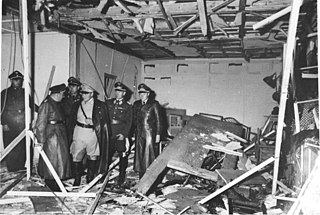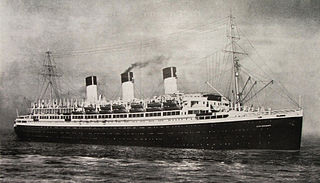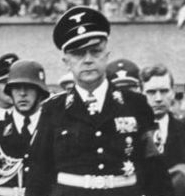
Courtney's War is a 2018 novel by Wilbur Smith and David Churchill. [1]

Courtney's War is a 2018 novel by Wilbur Smith and David Churchill. [1]
In the middle years of World War Two, Saffron Courtney, now a fully trained Special Operations Executive agent, is tasked with travelling to occupied Belgium and Holland to investigate a suspected major intelligence leak. With the help of Shasa Courtney and Blaine Malcomess, Saffron is given the identity of a fictional Afrikaner fascist sympathizer, allowing her to infiltrate the ranks of the Flemish National Union. She discovers that the Nazis have taken possession of all the S.O.E. radios within the Low Countries, allowing them to be forewarned of any intelligence work being carried out by S.O.E., while also learning of the Final Solution. She is then forced to go on the run from the Nazis and their collaborators after killing an SS officer attempting to rape her. With the help of the Belgian resistance and the R.A.F., she escapes back to Britain with her information.
Meanwhile, Saffron's lover, Luftwaffe pilot and German war hero Gerhard von Meerbach, participates in the Battle of Stalingrad and the subsequent doomed Nazi war effort. While drinking in a bar following the conflict and mourning the loss of one of his friends, he gets accosted by a drunken German soldier who accuses him of cowardice, prompting Gerhard to openly denounce Hitler in a furious outburst. Colonel Henning von Tresckow learns of Gerhard's words, and invites him to participate in the 20 July plot. After it fails, Gerhard's correspondence with von Tresckow is discovered by Gerhard's brother Konrad, a high-ranking member of the SS, who has him arrested for treason and arranges for him to stand trial at the People's Court. Not wanting to have such a widely regarded figure convicted of a capital crime, and having no decisive evidence against Gerhard, the Luftwaffe and SS agree to a deal in which Gerhard will be let off on minor charges if he swears an oath of loyalty to Hitler. Gerhard refuses to do so during his trial, and is imprisoned in Sachensausen concentration camp.
In 1945, Saffron is assigned to track down allied prisoners of war being held by the Nazis before they can be taken into the care of the Russians, in anticipation of the approaching Cold War, and discovers firsthand the horrors of the Holocaust. The prisoners, Gerhard among them, are moved to Dachau concentration camp, and then taken by members of the S.S. towards a Nazi alpine fortress, to be used as bargaining chips in negotiations with the Allies. A Wehrmacht unit takes possession of the prisoners and brings them to a luxury hotel to recover. Gerhard contracts typhus during this time and nearly dies, but Saffron - who had at this point given up on seeing Gerhard again - finds him and nurses him back to health.

Heinrich Luitpold Himmler was Reichsführer of the Schutzstaffel, and a leading member of the Nazi Party of Germany. Himmler was one of the most powerful men in Nazi Germany and a main architect of the Holocaust.

The Schutzstaffel was a major paramilitary organization under Adolf Hitler and the Nazi Party in Nazi Germany, and later throughout German-occupied Europe during World War II.

On 20 July 1944, Claus von Stauffenberg and other conspirators attempted to assassinate Adolf Hitler, Führer of Nazi Germany, inside his Wolf's Lair field headquarters near Rastenburg, East Prussia, now Kętrzyn, in present-day Poland. The name Operation Valkyrie—originally referring to part of the conspiracy—has become associated with the entire event.

Nacht und Nebel, meaning Night and Fog, was a directive issued by Adolf Hitler on 7 December 1941 targeting political activists and resistance "helpers" in the territories occupied by Nazi Germany during World War II, who were to be imprisoned, murdered, or made to disappear, while the family and the population remained uncertain as to the fate or whereabouts of the alleged offender against the Nazi occupation power. Victims who disappeared in these clandestine actions were never heard from again.

Irma Ilse Ida Grese was a Nazi concentration camp guard at Ravensbrück and Auschwitz, and served as warden of the women's section of Bergen-Belsen. She was a volunteer member of the SS.

SS Cap Arcona, named after Cape Arkona on the island of Rügen, was a large German ocean liner, later a ship of the German Navy, and finally a prison ship. A flagship of the Hamburg Südamerikanische Dampfschifffahrts-Gesellschaft, she made her maiden voyage on 29 October 1927, carrying passengers and cargo between Germany and the east coast of South America, and in her time was the largest and quickest ship on the route.

Dachau was the first concentration camp built by Nazi Germany, opening on 22 March 1933. The camp was initially intended to intern Hitler's political opponents which consisted of: communists, social democrats, and other dissidents. It is located on the grounds of an abandoned munitions factory northeast of the medieval town of Dachau, about 16 km (10 mi) northwest of Munich in the state of Bavaria, in southern Germany. After its opening by Heinrich Himmler, its purpose was enlarged to include forced labor, and, eventually, the imprisonment of Jews, Romani, German and Austrian criminals, and, finally, foreign nationals from countries that Germany occupied or invaded. The Dachau camp system grew to include nearly 100 sub-camps, which were mostly work camps or Arbeitskommandos, and were located throughout southern Germany and Austria. The main camp was liberated by U.S. forces on 29 April 1945.

Hans Paul Oster was a general in the Wehrmacht of Nazi Germany and a leading figure of the anti-Nazi German resistance from 1938 to 1943. As deputy head of the counter-espionage bureau in the Abwehr, Oster was in a good position to conduct resistance operations under the guise of intelligence work.

Henning Hermann Karl Robert von Tresckow was a German military officer with the rank of major general in the German Army who helped organize German resistance against Adolf Hitler. He attempted to assassinate Hitler on 13 March 1943 and drafted the Valkyrie plan for a coup against the German government. He was described by the Gestapo as the "prime mover" behind the plot of 20 July 1944 to assassinate Hitler. He committed suicide at Królowy Most on the Eastern Front upon the plot's failure.

Fort Breendonk is a former military installation at Breendonk, near Mechelen, in Belgium which served as a Nazi prison camp (Auffanglager) during the German occupation of Belgium during World War II.

Alice Orlowski was a German concentration camp guard at several of the German Nazi camps in German-occupied Poland (1939-1945) during World War II. After the war, she was convicted of war crimes.

Hans Achim Litten was a German lawyer who represented opponents of the Nazis at important political trials between 1929 and 1932, defending the rights of workers during the Weimar Republic.

Sigmund Rascher was a German Schutzstaffel (SS) doctor. He conducted deadly experiments on humans pertaining to high altitude, freezing and blood coagulation under the patronage of Reichsführer-SS Heinrich Himmler, to whom his wife Karoline "Nini" Diehl had direct connections. When police investigations uncovered that the couple had defrauded the public with their supernatural fertility by 'hiring' and kidnapping babies, she and Rascher were arrested in April 1944. He was accused of financial irregularities, murder of his former lab assistant, and scientific fraud, and brought to Buchenwald and Dachau concentration camps before being executed. After his death, the Nuremberg Trials judged his experiments as inhumane and criminal.
Operation Spark was the code name for the planned assassination of Nazi dictator Adolf Hitler by the anti-Nazi conspiracy of German Army officers and political conservatives, known as the Schwarze Kapelle during World War II. The name was coined by Major General Henning von Tresckow in 1941. He believed that because of Hitler's many successes up to that time, his personal charisma, and the oath of personal loyalty to him sworn by all German army officers, it would be impossible to overthrow Hitler and the Nazis with Hitler still alive. Hitler's death, however, would be a "spark"—a signal that it was time to launch an internal coup d'état to overthrow the Nazi regime and end the war.
Melitta Schenk Gräfin von Stauffenberg was an aviator who served as a test pilot in the Luftwaffe before and during World War II.

Josias, Hereditary Prince of Waldeck and Pyrmont was the heir apparent to the throne of the Principality of Waldeck and Pyrmont and a general in the SS. From 1946 until his death, he was the head of the Princely House of Waldeck and Pyrmont. After World War II, he was sentenced to life in prison at the Buchenwald Trial for his part in the "common plan" to violate the Laws and Usages of War in connection with prisoners of war held at Buchenwald concentration camp, but was released after serving about three years in prison.

Friedrich Karl Freiherr von Eberstein was a member of the German nobility, early member of the Nazi Party, the SA, and the SS. He was elected to the Reichstag and held the position of the chief of the Munich Police during the Nazi era. Eberstein was a witness at the Nuremberg Trials.

Fritz Suhren was a German SS officer and Nazi concentration camp commandant.
In Nazi Germany, Sonder- und Ehrenhaft was an administrative status assigned to certain particularly prominent political prisoners, notably political leaders of Nazi-occupied countries and disgraced members of the German elite. Because of their political value or former status, they were treated uncommonly well, and all but a few of them survived the war.